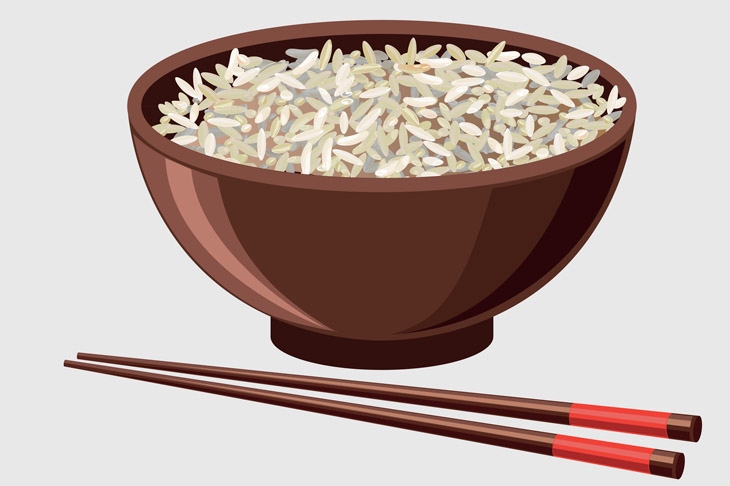Driving across Japan’s Shikuko island, the food and travel writer Michael Booth pulls into a filling station to find, alongside the fizzy drinks and chewing gum, ‘vacuum-packed octopus beaks’. Who could resist? Not Booth. ‘Very crunchy,’ he reports. ‘And not in a good way.’
Booth is drawn to the offbeat, and The Meaning of Rice gives us a banquet of the unfamiliar: seaweed caviar, live squid sashimi, sea-urchin tongues, snake soup, bonito guts, silkworm pupae, and more, with all their smells, flavours and textures. I recall my disconcerting first meal in a traditional ryokan: pink wafers of raw horsemeat, boiled firefly squid and dark, gleaming eel. It was delicious; Booth would have approved.
Ten years ago he took his wife and two toddler sons on a three-month Japanese trip, eating their way from the tip of Hokkaido to the toe of Okinawa. His book, Sushi and Beyond, became an international award-winning bestseller. In Japan, Sushi spawned a manga graphic book and a cartoon TV series starring the family; they had morphed into celebs — The Simpsons with soy sauce! Animé superheroes!
On that first trip Booth travelled innocent and wide-eyed, taking in everything; a camera with its shutter open, registering new sights, new delights. Now the family is back for a second helping, but this is a very different odyssey. Booth is famous, an aficionado on a gourmet grand tour: top restaurants, knockout menus and star chefs. He treats us to ‘the best meal in Japan’, which basically means the best meal in the world in his view. Occasionally, disaster strikes:
The rice bran had turned the fugu milt from white to muddy brown. It looked like a flattened piece of clay, smelled like an abandoned caravan and had a texture like overcooked liver…
Fugu milt is the roe of the poisonous blowfish — the author puts his life on the line in several culinary tightrope walks.
In The Almost Nearly Perfect People, the author lifted the lid on his Danish wife’s homeland. Eat, Pray, Eat, saw the Booth quartet exploring Indian food. The family is part of his shtick. The sons are teenagers now, and perhaps it was to reward the boys that they take in so many theme parks. And rather too often, the reader finds the dead hand of the local tourist board piloting the itinerary: the corporate meet-and-greet by the suits, the guided tour round the factory, the headquarters, a distillery. A ‘global challenge’ to find the world’s best sushi chef is actually a promotional exercise sponsored by the Norwegian Seafood Council.
What Booth does best is a masterclass in Japanese cuisine from haute to caff counter; he relishes a traditional, five-hour lunch and the skills that underpin it, but occasionally he turns against high-end pretensions:
I don’t want a concept, or a deconstruction, or a poshed-up bowl, I want thick, slightly chewy noodles, a soft-boiled, soy-soaked egg, a slice of tender chashu and a deep, rich soup… all for under a thousand yen. Is that too much to ask?
What eludes him in city after city is spirit of place. Unforgivably, in Nagasaki we get pages on the local Castella cake, the tourist museum on Dejima island and China Town en fête. Nothing of the vibrant city I remember, with remnants of the horrific past given their place among the rebuilt present. The atomic bomb memorial, a soaring tribute to the survival of the human spirit, merits no more than a brief paragraph; no mention of graceful stone temples clustered above the amphitheatre bay with its low, encircling hills. Booth moves on, to Sasebo – ‘hamburger city’, a nod to the 50,000 American servicemen based in Japan. And yes, the head of local tourism is waiting to show him around.
Happily, away from the organised tours are vivid encounters off the beaten track where Booth finds humbler heroes to celebrate. He joins fishermen harvesting sea-urchins on a pre-dawn expedition; talks to men and women working, fishing and cooking, with obsessive commitment. He meets a farmer living in the shadow of Fukushima, determined to produce the best rice in the world; an elderly couple dedicated to the refinements of rotten fish.
Beneath the light-hearted surface is a depth of research, respect and affection for Japanese culture and the quiet stoicism of its people. Rice itself remains unexplained, though the author and his sons learn how to plant it.
Finally, Booth points up a piquant irony: in 2013 Unesco awarded Japanese cuisine ‘Intangible Cultural Heritage’ status, but as others embrace their gastronomy, the Japanese have learned to love western fast food, taking on more fat and carbs, cutting down on their own traditional healthy diet and eating less rice. Meanwhile Japanese food has taken up residence on the British high street: supermarkets stock sushi lunch-packs with wasabi peas stacked alongside salt and vinegar crisps. Ponzu dipping sauce is so popular that Tesco and Asda do their own. Is sushi the new chicken tikka masala?






Comments